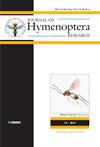基于 DNA 条形码的诱捕巢定量研究穴巢蜂幼虫食物资源的方法
IF 1.4
3区 农林科学
Q2 ENTOMOLOGY
引用次数: 0
摘要
人工筑巢资源(也称为诱捕巢)已被证明是监测穴巢蜜蜂和黄蜂、其采集的食物资源以及天敌的理想方法。如今,诱捕巢经常被用来评估基于多营养体相互作用网络的环境和生物多样性变化的反应。在这里,我们利用DNA条形码重建了五种poid黄蜂(Trypoxylon clavicerum、Passaloecus corniger、Passaloecus gracilis、Psenulus fuscipennis、Isodontia mexicana)和两种vespid黄蜂(Ancistrocerus nigricornis、Microdynerus parvulus)的定量营养相互作用网络。在筑巢期间对巢穴进行取样,使我们能够对提供的食物进行准确的计数和鉴定。我们发现了高度分明的两方和三方网络,包括黄蜂-甲虫幼虫、黄蜂-蟋蟀、天敌-黄蜂-蛾幼虫、天敌-黄蜂-蜘蛛以及天敌-黄蜂-蚜虫等。后者包括被称为农业和森林害虫的蚜虫种类。虽然对巢穴进行定量取样会增加时间成本,但它不仅能进行高质量的 DNA 条形编码,还能重建定量的相互作用网络。因此,我们的方法是一种非常有前途的监测工具,可用于深入了解生态学、栖息地要求以及环境和生物多样性变化对穴巢蜜蜂和黄蜂的影响。本文章由计算机程序翻译,如有差异,请以英文原文为准。
A DNA-barcoding-based approach to quantitatively investigate larval food resources of cavity-nesting wasps from trap nests
Artificial nesting resources, also known as trap nests, have proven to be an ideal method for monitoring cavity-nesting bees and wasps, their collected food resources, and natural enemies. Nowadays, trap nests are frequently used to assess responses to environmental and biodiversity changes based on multi-trophic interaction networks. Here, we reconstructed quantitative trophic interaction networks of five apoid wasps (Trypoxylon clavicerum, Passaloecus corniger, Passaloecus gracilis, Psenulus fuscipennis, Isodontia mexicana and two vespid wasp species (Ancistrocerus nigricornis, Microdynerus parvulus) using DNA barcoding. Sampling the nests during their construction period allowed us to give an accurate count and identification of the provided food items. We recovered highly resolved bi- and tripartite networks including wasp-beetle larva, wasp-cricket, natural enemy-wasp-moth larva, natural enemy-wasp-spider, and natural enemy-wasp-aphid associations. The latter include aphid species that are known as agricultural and forest pests. Although the quantitative sampling of nests entails increased time costs, it enables not only high-quality DNA barcoding but also to reconstruct quantitative interaction networks. Thus, our approach is a highly promising monitoring tool for gaining deeper knowledge on the ecology, habitat requirements and the impact of environmental and biodiversity change on cavity-nesting bees and wasps.
求助全文
通过发布文献求助,成功后即可免费获取论文全文。
去求助
来源期刊
CiteScore
2.60
自引率
15.40%
发文量
68
审稿时长
>12 weeks
期刊介绍:
The Journal of Hymenoptera Research is a peer-reviewed, open-access, rapid online journal launched to accelerate research on all aspects of Hymenoptera, including biology, behavior, ecology, systematics, taxonomy, genetics, and morphology.
All published papers can be freely copied, downloaded, printed and distributed at no charge for the reader. Authors are thus encouraged to post the pdf files of published papers on their homepages or elsewhere to expedite distribution. There is no charge for color.

 求助内容:
求助内容: 应助结果提醒方式:
应助结果提醒方式:


